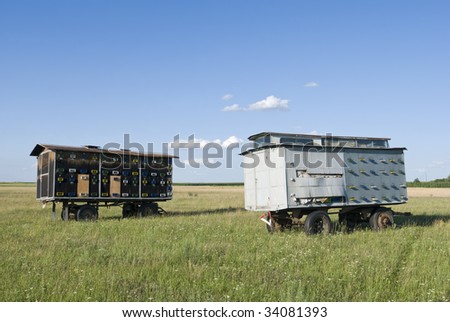ok, lets try again.
12 hive brood boxs when full will weigh around 30 kg lets be safe and call it 40 kg,
40kg brood boxs times 12 is 480kg, thats half a ton in old english still way under the three ton limit, even if you were to travel with three supers on which you wont because they fall off, it still would be around 20kg per super three per hive plus brood =100kg, times twelve thats still 1200kg or one point two tons, plus the kalf ton of the trailer dont forget so 1.7 tons
so forget they weight limit rubbish people keep talking about as we are well under what a normal eastate car can tow let alone getting a landy rover involved, so now we have sorted the weights and i am sure someone will argue with that
the trailer is better off with a solid base that the hives can be tied down to or screwed to, the guy i used to work for in wales, who used to use a set up of a doxen of these trailers, had the trailer base built out of timber battons mainly 3" by 2" and they were set out that each hive base had two under the edges of the brood box plus a piece of thick ply with the mesh cut into it, just like a normal hive stand would, this also allowed him to use when he wanted to rachet straps all the way around
next each hive was made from wood, home built rough jobs not nice new ones, the base panel was screwed to the timber frames first , then stacked on top was the rest of the boxs, the only differance was each corner at the top of each box was a simple steel bracket, a bit like one of these
http://www.toolstation.com/shop/Structural/Builders+Metalwork/d210/sd2797
Corner Stretcher Plates
these kept the hive is place and stopped it sliding around or twisting the straps were used to take it from one crop to another.
management wise we used to take the trailer to the next crop depending on what was in flower and when when set up we used the corner steadys of the caravan and then removed the wheeels to prevent theft and some times unbolted the towing eye as well
we would then add two supers on top of each brood box. the lot was left alone for a week and when inspected we would check the supers for fullness and go through the brood boxs, personaly we used to only ever use two supers per hive, removing either full supers as and when, or we would take say four full frames from one hive and and some more from the other hives to make up the 9 in a box,
because he used to extract almost every day or realy Susan his wife did, , osr was not a problem going hard. it also kept the wax production up as well which was another main crop for him,
we only ever used to add more supers if the they were going to be left alone for three weeks in which case he would add four supers per hive and these would be removed be for trying to tow the trailer, the most he ever towed with was two supers on
robbing?? , the bees he would say are going to rob one of my hives to fill one of my hives so where s the loss, now if they were going to be robbed by someones elses bees thats differant .
lastly was how long to leave them on the crop, we used to leave them untill the flowers were almost gone or the next crop was coming good, if there was no field of flowers we used to run them up to the moor lands as they would then slow down and start on the heather or he would take them home to feed on the local garden flowers,
he used to have like i said around 15 trailers in use working an area of mid wales but he used to trailer over to the rape fields of herefordshire the fruit farms of worcestershire and a few other areas to , so you can go to the best forage areas when ever they are ready for you





















































